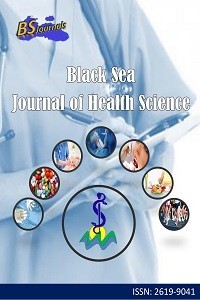Performance Comparison of Neural Network-Based Models in the Classification of Polycystic Ovary Syndrome Disease
PCOS, MLP, ANN, Deep learning, Classification
Performance Comparison of Neural Network-Based Models in the Classification of Polycystic Ovary Syndrome Disease
PCOS, MLP, ANN, Deep learning, Classification,
___
- Abdar M, Yen NY, Hung J. CS. 2018. Improving the diagnosis of liver disease using multilayer perceptron neural network and boosted decision trees. J Med Biol Engin, 38(6): 953-965.
- Aggarwal, C. C. 2018. Neural networks and deep learning. Springer, 10, 978-973.
- Ayşe A, Berberler ME. 2017. Yapay sinir ağları ile tahmin ve sınıflandırma problemlerinin çözümü için arayüz tasarımı. Acta Infologica, 1(2): 55-73.
- Azziz R. 2016. New insights into the genetics of polycystic ovary syndrome. Nature Rev Endocrinol, 12(2): 74-75.
- Deshmukh H, Papageorgiou M, Kilpatrick E, Atkin S, Sathyapalan T. 2018. Development of a novel risk prediction and risk stratification score for polycystic ovary syndrome. Clin Endocrinol, 90(1): 162-169.
- El-Mahelawi JK, Abu-Daqah JU, Abu-Latifa RI, Abu-Nasser BS, Abu-Naser SS. 2020. Tumor classification using artificial neural networks. Inter J Acad Engin Res, 4: 11.
- Esteva A, Robicquet A, Ramsundar B, Kuleshov V, DePristo M, Chou K, Dean J. 2019. A guide to deep learning in healthcare. Nature Med, 25(1): 24-29.
- Gönül Y, Ulu Ş, Bucak A, Bilir A. 2015. Yapay sinir ağları ve klinik araştırmalarda kullanımı. Genel Tip Derg, 25(3): 1-10.
- Karasu S, Saraç Z. 2020. Classification of power quality disturbances with hilbert-huang transform, genetic algorithm and artificial intelligence/machine learning methods. J Polytech, 23(4): 1219-1229.
- Kashaninejad M, Dehghani A, Kashiri M. 2009. Modeling of wheat soaking using two artificial neural networks (MLP and RBF). J Food Engin, 91(4): 602-607.
- Kayaalp K, Süzen A. 2018. Derin öğrenme ve Türkiye’deki uygulamaları. IKSAD International Publishing House, Adıyaman, Türkiye, 1. Baskı, ss. 89.
- Keleş A. 2018. Derin öğrenme ve sağlık alanındaki uygulamaları. Elect Turkish Stud, 13(21): 113-127.
- Kilic D, Güler, T, Alataş, E. 2020. 2018 Uluslarası kanıta dayalı polikistik over sendromu değerlendirme ve yönetim rehberi doğrultusunda uzun dönem risklerin yönetimi. Pamukkale Tıp Derg, 13(2): 453-461.
- LeCun Y, Bengio Y, Hinton G. 2015. Deep learning. Nature 521 (7553): 436-444.
- Orhan U, Hekim M, Özer M. 2010. Discretization approach to EEG signal classification using Multilayer Perceptron Neural Network model. In: 15th National Biomedical Engineering Meeting, 21-24 April, Antalya, Turkey, pp. 1-3.
- Öztemel E. 2003. Yapay sinir ağları. Papatya Yayıncılık, İstanbul, Türkiye, 4. Baskı, ss. 232.
- Satish CN, Chew X, Khaw KW. 2020. Polycystic Ovarian Syndrome (PCOS) classification and feature selection by machine learning techniques. Applied Math Comput Intel, 9: 65-74.
- Schmidhuber J. 2015. Deep learning in neural networks: An overview. Neural Networks, 61: 85-117.
- Steegers-Theunissen RPM, Wiegel RE, Jansen PW, Laven JSE, Sinclair KD. 2020. Polycystic ovary syndrome: A brain disorder characterized by eating problems originating during puberty and adolescence. Inter J Molec Sci, 21(21): 8211.
- Şeker A, Diri B, Balık HH. 2017. Derin öğrenme yöntemleri ve uygulamaları hakkında bir inceleme. Gazi Müh Bilim Derg, 3(3): 47-64.
- Wang X, Zhao Y, Pourpanah F. 2020. Recent advances in deep learning. Inter J Machine Learn Cybernet, 11: 747–750.
- Yüce E, Pabuccu R, Keskin M, Arslanca T, Pabuçcu EG. 2020. Polikistik ovary sendromlu ergen ve yetişkin hastalar arasındaki klinik, endokrinolojik ve biyokimyasal farkların değerlendirilmesi. Turkish J Reprod Med Surgery, 4(1): 15-23.
- Yayın Aralığı: Yılda 4 Sayı
- Başlangıç: 2018
- Yayıncı: Cem TIRINK
Investigation of the Perceived Corporate Image and Organizational Commitment of Nurses and Midwives
Tuğba GÜNGÖR, Ayşegül OKSAY ŞAHİN
Üniversite Öğrencilerinde Mikro Besin Ögesi Alımının ve Beslenme Bilgi Düzeyinin Değerlendirilmesi
Banu TERZİ, Şehrinaz POLAT, İnci KAVLU, Hamdiye Banu KATRAN, Nurten KAYA
Miray Kübra TURGUT AKSU, Emel YILDIZ, Canan BALCI
Hamide ŞİŞMAN, Refiye ÖZGEN, Dudu ALPTEKİN, Sevban ARSLAN
Bazı Popüler Diyetlerin İmmünite Üzerine Etkileri
Emre ADIGÜZEL, Şeyma Nur KILIÇ, Almina YILMAZ, Gizem YURDAKUL, Ülkü Didar BİLEN, Ahsen TENİL, İrem YILMAZ
A Scientometric Analysis on Cardiac Echinococcosis
Cemile UYAR, Emine Kübra DİNDAR DEMİRAY, Serpil OĞUZ MIZRAKÇI, Mustafa Serhat ŞAHİNOĞLU
Zeynep KÜÇÜKAKÇALI, Fatma Hilal YAĞIN, İpek BALIKÇI ÇİÇEK
Mehmet YETİŞ, Mehmet CANLI, Ömer Alperen GÜRSES, Hikmet KOCAMAN, Ozkan GORGULU
Canan ERAYDIN, Berkay ÇORBACI, Üzeyir DİNİ, Hamza UYSAL, Esra YILDIRIM
